Tattoo stenciling is an essential step towards getting perfect artwork on your skin. A tattoo stencil serves as a roadmap for tattoo artists to create their masterpieces with accuracy and precision. However, choosing the right pen for a tattoo stencil is a crucial decision that should not be taken lightly. So, if you’re wondering what pen to use for a tattoo stencil, then you’ve come to the right place. In this article, we’ll unlock the secrets of tattoo stencils and reveal the best pen options available for achieving the best results.
Contents
Types of Tattoo Stencils
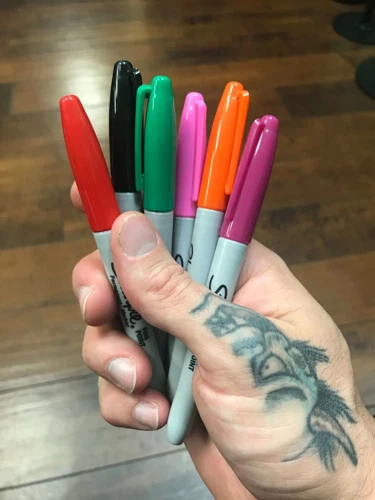
Paper Stencils
Paper stencils are one of the most commonly used stencils in tattooing. They are created by drawing or printing the design on paper and then applying a layer of adhesive to the back of the paper. The paper is then applied to the skin and the design is transferred by applying pressure with a pen or other tool.
When using paper stencils, it is important to use a clean, sharp pen to ensure the best results. Permanent markers or fine-point sharpies work well, as they are easy to control and produce clean lines. Be sure to avoid using a water-based pen as it can cause the ink to bleed and the stencil to smudge.
Thermal Stencils
Thermal stencils are created using a thermal printer that prints the design onto a special type of paper. The paper is then separated, and the top layer is applied to the skin. Heat is then applied to the back of the paper, causing the ink to transfer to the skin.
To get the best results when using thermal stencils, it is important to use a thermal printer with high-quality ink. This ensures that the design will transfer cleanly and accurately. Additionally, be sure to use a stencil transfer solution, such as stencil stuff or spirit transfer cream, to help the stencil adhere to the skin.
Transfer Stencils
Transfer stencils are created using a transfer machine that draws the design onto a stencil sheet. The stencil is then applied to the skin by removing the stencil backing and placing the adhesive side onto the skin.
When using transfer stencils, it is important to use a clean, precise pen that will not smudge or bleed. A fine-point pen, such as a sharpie or pen with a 0.5mm or smaller tip, works well for creating clean, precise lines.
In summary, choosing the right pen for tattoo stencils depends on the type of stencil being used. Using a clean, sharp pen is essential for creating crisp, clean lines and ensuring the stencil adheres properly to the skin. Be sure to consider the type of stencil being used and choose a pen that will provide the best results for the design you are creating.
What Pens to Use for Tattoo Stencils
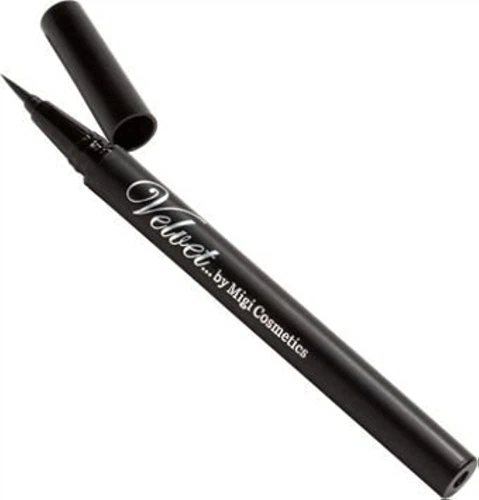
Characteristics of a Good Tattoo Stencil Pen
When looking for a pen to use for tattoo stencils, there are certain characteristics to consider.
- Waterproof and Smudge-Proof: A good tattoo stencil pen should be waterproof and smudge-proof to prevent the stencil from washing away or smudging during the tattooing process.
- Sharp and Accurate: The pen tip should be sharp and accurate for creating clean and precise lines, ensuring the stencil is accurate and easy to follow.
- Long-Lasting: The pen should be long-lasting to withstand the demands of the tattooing process.
Pen Types
There are different types of pens that can be used for tattoo stencils:
- Stencil Pens: Specifically designed for tattoo stencils and are often waterproof and smudge-proof.
- Ballpoint Pens: Often used by tattoo artists to create initial sketches or outlines of a design, but are not recommended for creating stencils due to their smudging and fading tendencies.
- Technical Pens: These pens have a fine needle tip and come in a range of tip sizes, making them a popular choice among tattoo artists for creating stencils.
Overall, it’s important to use a good quality tattoo stencil pen that meets the necessary characteristics to ensure a successful tattooing process.
Ballpoint Pens
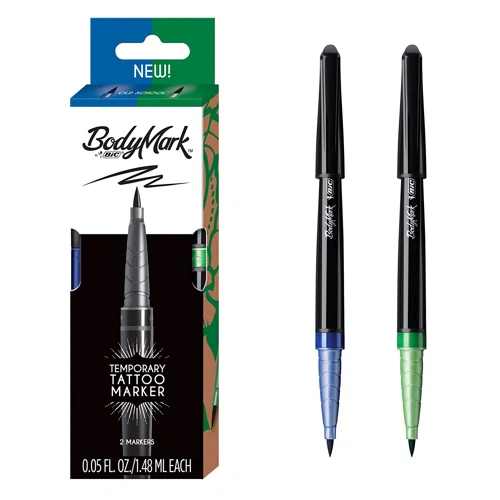
Ballpoint pens have come a long way since their initial invention in the early 20th century. Today, they are one of the most popular writing instruments in the world. The design of the ballpoint pen is simple – it consists of a small rolling ball at the tip that transfers ink onto paper as it rotates.
When it comes to selecting the best ballpoint pen for tattoo stencils, there are a few factors to consider. The first is the ink’s permanence – you want to choose a pen with ink that will not smudge or rub off easily. Additionally, you want a pen that has a fine tip to allow for precise and intricate lines.
Here’s a comparison table of the top 3 ballpoint pens that are commonly used for tattoo stencils:
| Brand | Ink Permanence | Tip Size |
|---|---|---|
| Bic Cristal | Low | Medium |
| Pilot Precise V5 | High | Extra Fine |
| Zebra F-301 | Medium | Extra Fine |
The Bic Cristal is a classic ballpoint pen that is easy to find in many stores. However, its ink permanence is low, meaning it can smudge easily. The Pilot Precise V5 has a higher ink permanence and an extra-fine tip, giving it the precision needed for tattoo stencils. The Zebra F-301 is another reliable choice with a medium ink permanence and an extra-fine tip.
In summary, when choosing a ballpoint pen for tattoo stencils, look for a pen with a fine tip and high ink permanence. The Pilot Precise V5 and Zebra F-301 are great options that will give you the precision and permanence you need for your tattoo stencils.
Felt Pens
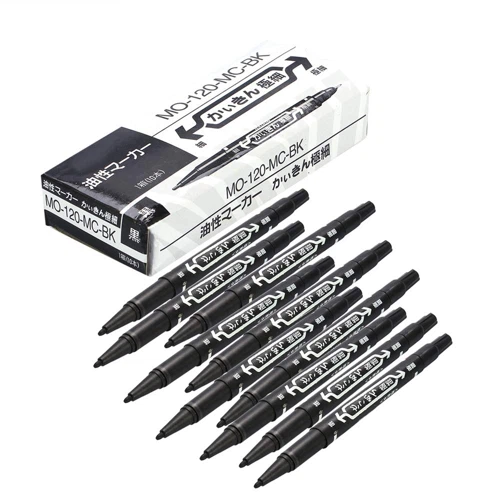
Felt pens, also known as markers, are a popular choice for creating tattoo stencils. These pens are made with a porous tip made of felt or other fibers which allow for a smooth and consistent flow of ink.
When using felt pens for tattoo stencils, it is important to choose one with a fine tip for precise outlining. Fine tip felt pens allow for greater control and accuracy, resulting in a more detailed and intricate stencil.
Another important factor is the quality of the ink. High-quality felt pens are made with acid-free, fade-resistant ink that flows smoothly and evenly onto the stencil paper. This ensures that the stencil will remain clear and legible throughout the tattooing process.
It is also important to choose a felt pen with a water-resistant ink to prevent smudging or bleeding during the tattooing process. This will ensure that the stencil remains intact and accurate throughout the entire tattooing process.
Overall, felt pens are an excellent choice for creating tattoo stencils. When choosing a felt pen, select one with a fine tip, high-quality ink, and water-resistant properties for the best results.
Gel Pens
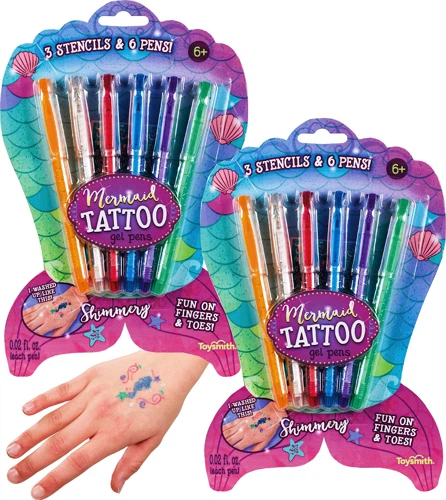
Ink Types
Gel pens are an excellent option to use when it comes to tattoo stencils. When it comes to ink types for gel pens, there are a few things you need to consider to achieve the best results.
Firstly, waterproof ink is essential. Tattoo stencils can often come into contact with liquids during the tattooing process, so it’s crucial that the ink used in the pen is waterproof. This ensures that the stencil will remain in place, even during the tattooing process.
Secondly, the quality of the ink is important. It’s essential to use an ink that is designed for stenciling purposes, as this ensures that the lines will be crisp and clear.
Finally, the pen tip should be considered. A fine tip is ideal for creating precise, clean lines. A pen with a thicker tip may cause smudging or bleeding, which can result in an untidy stencil.
Overall, using a gel pen with waterproof ink, high-quality ink, and a fine tip is the best option to achieve a sharp, clear tattoo stencil.
Waterproof Ink
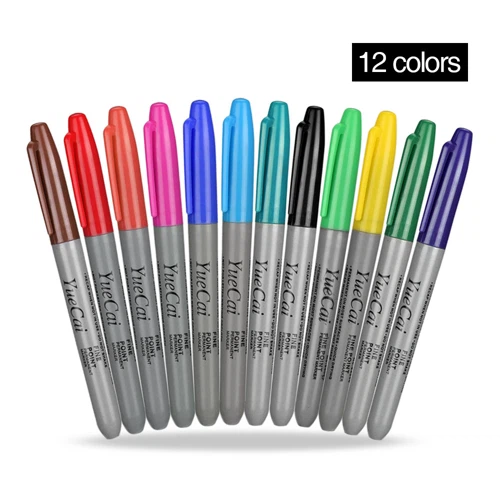
When it comes to creating tattoo stencils, using a waterproof ink is essential to ensure the design is accurately transferred to the skin. The ink must be able to withstand the application process, including wiping and cleaning, without smudging or fading.
There are several types of waterproof ink available in the market, including:
India ink: This type of ink is traditionally used for calligraphy and has a high concentration of pigment, making it ideal for creating dark lines. It is also water-resistant and prevents smudging from moisture.
Stencil ink: As the name suggests, this ink is specifically designed for creating stencils. It is highly pigmented and dries quickly, making it perfect for use in a tattoo environment. Stencil ink is also waterproof and can withstand the wiping and cleaning process.
Sharpie markers: Although not specifically designed for tattoo stencils, Sharpie markers are a popular choice because they are readily available and easy to use. However, it is important to note that not all Sharpie markers are waterproof, so be sure to select a suitable option.
When choosing a waterproof ink for tattoo stencils, it is important to select a high-quality product that is both reliable and durable. Taking the time to carefully consider the available options and select the best ink for your needs will result in a more accurate and long-lasting stencil.
Alcohol-Based Ink
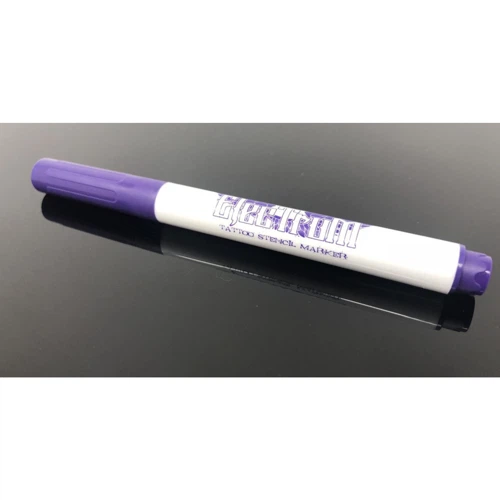
- Definition: Alcohol-based ink is a type of ink that is made up of colored pigments and alcohol as a solvent. It is widely used for drawing, coloring, and labeling on various surfaces, including paper, plastic, glass, and metals.
- Benefits: Alcohol-based ink is known for its quick drying time, vibrant colors, and long-lasting properties. It is also waterproof and smudge-proof, making it a popular choice for labeling items that will be exposed to moisture or handling.
- Uses in Tattooing: Alcohol-based ink is also commonly used in tattooing to create stencils. Its quick drying time and smudge-proof properties make it ideal for transferring the stencil design onto the skin. It can be used with a stencil machine or manually by hand using tracing paper.
- Precautions: When using alcohol-based ink for tattoo stencils, it is important to use gloves and work in a well-ventilated area as the fumes can be toxic when inhaled. It is also important to use only high-quality alcohol-based ink that is specifically designed for tattooing to ensure the safety of the client and longevity of the tattoo.
- Conclusion: Alcohol-based ink is a versatile and reliable option for creating tattoo stencils. Its quick drying time and waterproof properties make it a preferred choice for many tattoo artists. When using alcohol-based ink, it is important to take the necessary precautions to ensure the safety of both the artist and the client.
Best Practices for Using Pens for Tattoo Stencils

Preparing the Skin
Before applying the tattoo stencil, make sure that the client’s skin is clean and dry. Use an alcohol wipe to clean the area thoroughly to ensure that the stencil will stick to the skin properly. It is also important to shave the area where the tattoo design will be placed, as body hair can prevent the stencil from adhering correctly.
Applying the Tattoo Stencil
Choose a pen that is specifically designed for tattoo stencils, such as a surgical marker or a skin-safe pen. These pens are usually made with non-toxic ink and are gentler on the skin, reducing the risk of irritation or infection. Apply the stencil with firm pressure to ensure that the lines are clear and easy to follow.
Drawing the Tattoo Design
Once the tattoo stencil is applied, you can begin drawing your design. Use a pen with a fine point and a steady hand to create clear and precise lines. If you make a mistake, don’t panic – use a cotton swab dipped in rubbing alcohol to remove the incorrect lines before they set. Keep in mind that the stencil is just a guide, and your drawing should ultimately be a reflection of your skill and creativity.
By following these best practices when using pens for tattoo stencils, you can ensure that your designs are accurate, bold, and long-lasting. Remember, the success of a tattoo depends on the skill and expertise of the artist, so always take your time and approach the process with patience and care.
Advantages and Disadvantages of Using Pens for Tattoo Stencils
Using pens for tattoo stencils has become common in the tattoo industry. Here are some advantages and disadvantages of using pens for tattoo stencils.
| Advantages | Disadvantages |
|---|---|
| Easy and quick to use | May smudge or fade easily |
| Wide variety of pens available in the market | Not permanent |
| Cheap and easily accessible | May cause irritation or allergies on the skin |
| Can be used on any skin color and type | May not be suitable for intricate designs |
| Can be used on any part of the body | Does not provide a clean and crisp outline |
Despite these advantages and disadvantages, pens can be great for simple designs and as a quick solution. However, if you are looking for a long-lasting outline or intricate design, it is recommended to use specific tattoo pens or a professional tattoo stencil machine. It is important to discuss with your client about their skin type and allergies before using any type of pen for a tattoo stencil.
In conclusion, depending on the design and the client’s needs, the choice of what pen to use for tattoo stencil can vary. It is recommended to experiment with different techniques and tools to find what works best for your style and preferences.
Frequently Asked Questions
What type of pen is best for drawing tattoo stencils?
When it comes to creating perfect tattoo stencils, choosing the right pen can make all the difference. Here are some of the best types of pens for drawing tattoo stencils:
- Stabilo All pencils: Stabilo All pencils are a popular choice among tattoo artists for creating stencils. These pencils produce a clean, crisp line that transfers well onto the skin. They also come in a range of colors, making it easy to create detailed stencils.
- Fine-tip Sharpies: Fine-tip sharpies are another favorite among tattoo artists. They produce a bold, black line that is easy to see and transfer. They also have a fast-drying ink, which is essential when working on skin.
- Stencil pens: Stencil pens are specifically designed for creating stencils. They produce a fine, precise line and are available in different colors. They’re also water-resistant and can withstand the transfer process without smudging or fading.
- Mechanical pencils: Mechanical pencils are a good choice for creating detailed stencils as they produce a fine, consistent line. They are also easy to control and can be used to create intricate designs.
- White gel pens: White gel pens are a great choice for dark skin or when working with white ink. They produce a clean, visible line that makes it easy to transfer the stencil onto the skin.
No matter which pen you choose, it’s important to test it on a small area of skin before using it to create a stencil. This will ensure that the ink transfers correctly and that there are no allergic reactions to the ink. So, choose the pen that suits you the best and go ahead to make that perfect tattoo stencil without any hassle!
How should a tattoo stencil be applied to the skin?
Once you have your design ready, the next step is to create a stencil that will guide the needle during the tattooing process. Applying the stencil correctly to the skin is essential for a flawless and long-lasting tattoo. Here are the steps you need to follow for a successful application:
- Clean the skin thoroughly: Before applying the stencil, make sure that the skin area is free of dirt, oil, and other residues that may affect the quality of the transfer. Use rubbing alcohol or a soap that is gentle enough not to irritate the skin.
- Prepare the stencil: Cut the stencil to the appropriate size and shape, and remove the protective layer. Place the stencil ink-side down on the skin and press gently to avoid smudging the transfer.
- Transfer the design: Rub the back of the stencil evenly and firmly using a stencil transfer solution or a deodorant stick. This will help to transfer the design onto the skin, leaving a clean and accurate outline.
- Remove the stencil: Once you have transferred the design, carefully peel off the stencil to reveal the transferred image. Make sure not to touch the transfer with your fingers or clothing, as it may cause smudging or fading.
- Feedback and correction: Finally, ask the client to review the design and make any necessary adjustments before proceeding with the tattoo. This will ensure that the final product meets their expectations.
Remember, a well-applied tattoo stencil is essential for achieving a high-quality tattoo. By following these steps and using the proper tools and solutions, you can ensure a clean and accurate transfer that will guide your needle and set the foundation for a stunning and long-lasting masterpiece.
How long do tattoo stencils last on the skin?
Tattoo stencils are crucial for creating an accurate and long-lasting tattoo design. Once the stencil is applied to the skin, it serves as a guide for the tattoo artist to follow. But, how long do these stencils last on the skin?
- Generally, a tattoo stencil can last on the skin anywhere from 24 to 48 hours.
- The lifespan of a tattoo stencil can vary depending on various factors such as the type of pen used, the quality of the stencil paper, and where on the body the stencil is applied.
- Using a high-quality stencil paper and a professional-grade tattoo pen can help the stencil last longer on the skin.
- In some cases, a tattoo artist may need to reapply the stencil during the tattooing process to ensure the design remains accurate.
It’s important to note that while the stencil may fade or smudge over time, it should still be visible enough for the tattoo artist to follow and create a high-quality tattoo.
Overall, while tattoo stencils may not last on the skin forever, they are an essential tool for creating a beautiful and long-lasting tattoo design. It’s important to choose high-quality materials and work with a skilled tattoo artist to ensure the best results.
Is there any way to make a tattoo stencil more permanent?
Yes, there is. One way to make your tattoo stencil more permanent is to use a stencil transfer gel. This will help the stencil adhere to the skin better, making it less likely to smudge or rub off during the tattooing process. Another option is to use a stencil stay spray, which can help to keep the stencil in place for a longer period of time. Additionally, using a high-quality tattoo stencil pen can also help to ensure that the stencil lasts for as long as possible during the tattooing process.
Are There Any Special Techniques for Shading a Tattoo Stencil?
The shading of a tattoo stencil plays a crucial role in the outcome of a tattoo, and therefore, it is essential to have the right techniques. Here are some tips that can help you in achieving the best results during shading:
- Choose the Right Tools: The tools used for shading a tattoo stencil depend on the type of shading you want for your tattoo. For instance, if you want a soft shaded look, a magnum needle will do the job. But for a bold or crisp shading, you might need a shader needle or a round needle.
- Less is More: Shading a tattoo stencil is all about less is more. Do not push too hard or too deep into the skin as it may cause damage to the skin or bleeding. A gentle hand will give you the desired result.
- Use a Light Hand: One of the most important techniques for shading is to use a light hand. It will help you in creating a soft and natural-looking tattoo. Always remember, the more pressure you put while shading, the darker the tattoo will look.
- Create Different Depths: To create depth in your tattoo, you need to use different shades of colors. Start with the lighter shades and move slowly towards the darker areas. This technique will give you a natural-looking tattoo.
- Blend Colors: Lastly, blending colors is the key technique to make your shading look perfect. To blend colors, you need to switch between needles and colors often. This technique will create a smooth transition and give life to your tattoo.
In conclusion, there are several techniques you can use for shading a tattoo stencil. Choosing the right tools, using a light hand, creating different depths, and blending colors can help you in achieving the best result. Remember, practice makes perfect, so keep practicing to master the art of tattoo shading.
Conclusion
Using the right pen is key to achieving the best results when creating a tattoo stencil. Fine-tipped felt pens and markers are typically the best choice for outlining, while markers and pens with thicker tips are ideal for filling in large areas. It is important to test the pen on a piece of paper before applying the stencil to skin. By doing this, artists can guarantee the consistency of their lines and ensure that their stencils are accurate and clear.